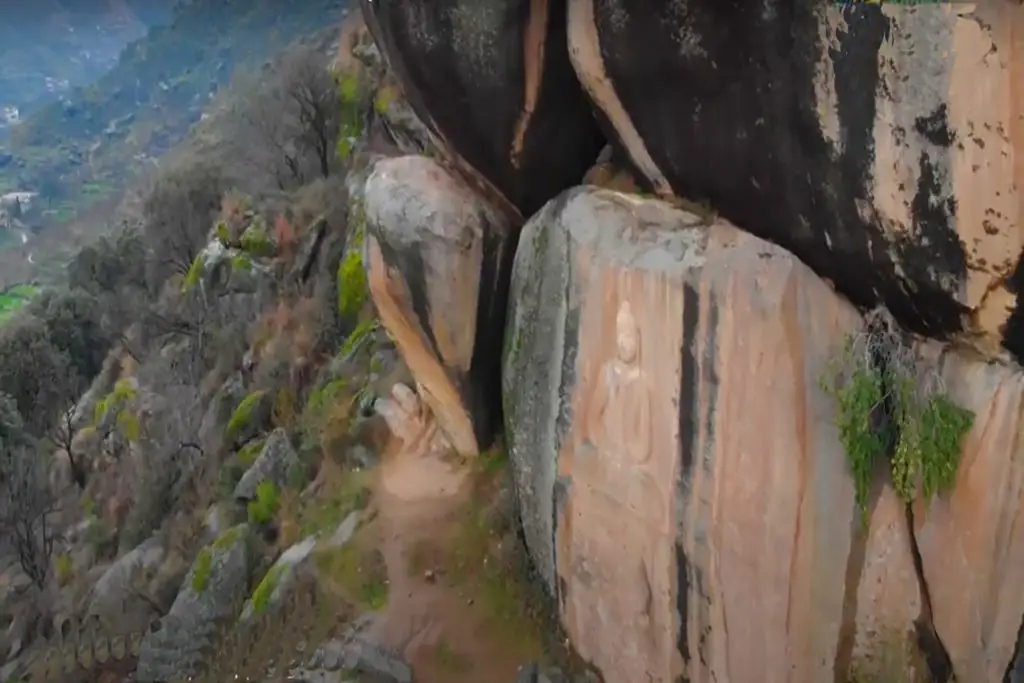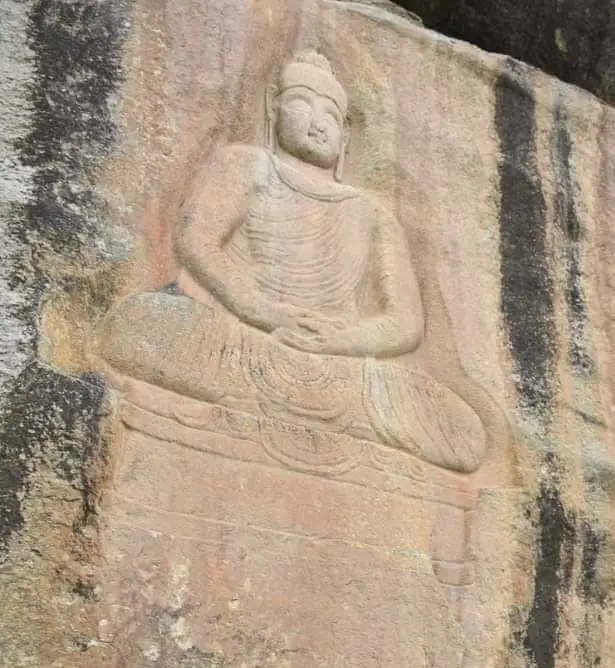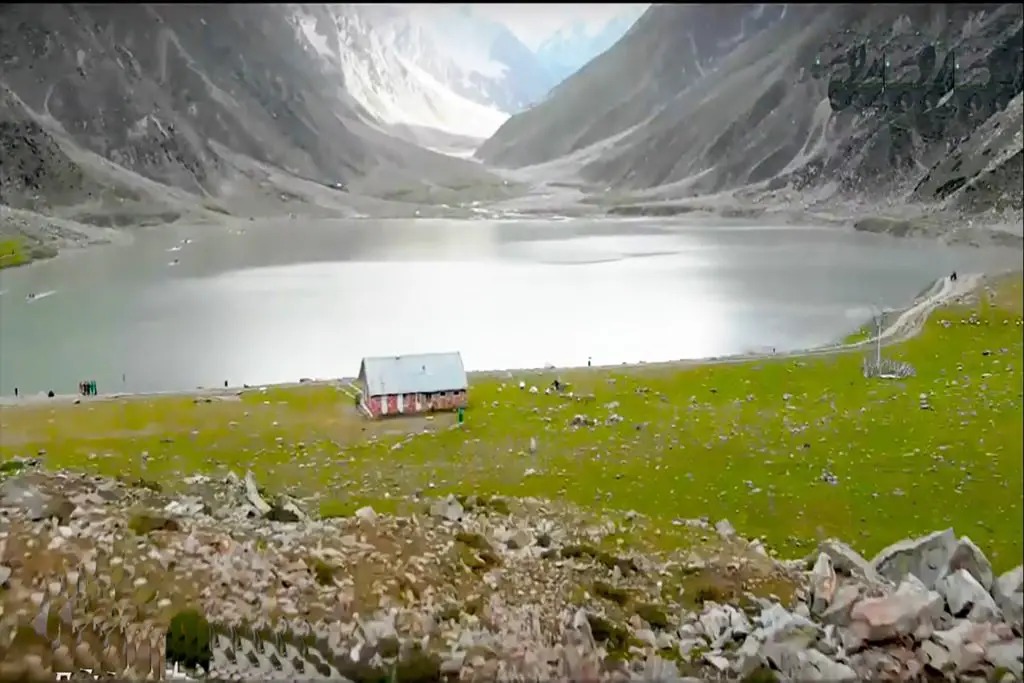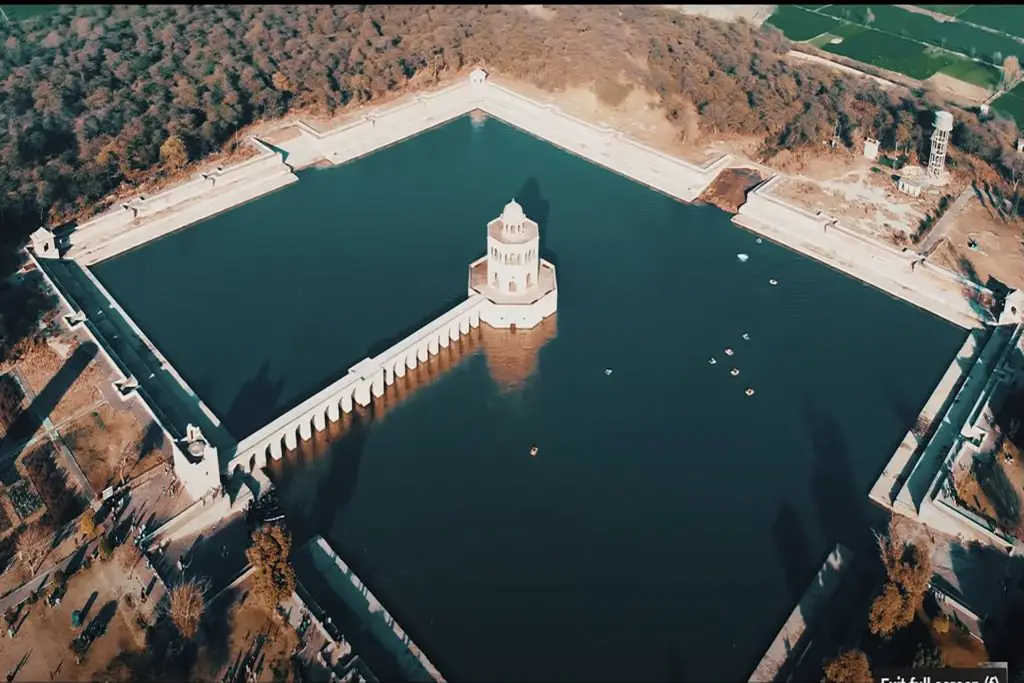In the picturesque region of Swat, tucked away amidst the serene landscapes and lush fields, lies an awe-inspiring masterpiece of ancient art and spirituality: the Jahanabad Seated Buddha. Located on the right side of the Malam Jabba Road, not far from Mungur, this monumental rock-carved Buddha is a testament to the rich history and culture of the Gandhara region.
Historical Significance
The Jahanabad Seated Buddha is Central Asia‘s largest statue of Mahatma Buddha, and it proudly graces the hillside to the southwest of Jehanabad (Shakhorai) village. This remarkable sculpture is believed to be the most remarkable piece of rock carving in the entire Gandhara region according to archaeologists. Its sheer size and detailed craftsmanship make it a true gem of ancient art.
Carved into a steep, reddish-colored rock wall that ascends the slope southwest of Jehanabad (Shakhorai) village, stands an immense representation of the Jahanabad Seated Buddha. Situated approximately 5 km northeast of Manglawar, this colossal Buddha image is visible from the road, particularly on the right side when traveling towards Malam Jabba.
Perched atop a high position above a narrow terrace, the Jahanabad Seated Buddha remains well-preserved, save for a nose that bears signs of vandalism. This Buddha figure, towering at about 7 meters, stands as the most remarkable sculpture within the Gandhara region.
The commanding Buddha is depicted in a meditative posture, seated on an elevated throne. The meticulous rendering of the snail shell curls adds to its intricate detailing. With eyes more than halfway closed, a prominent Ushnisha, and elongated earlobes, the figure exudes a sense of serenity. The fibrous folds of the robe, characterized by a deliberate interplay of high and low ridges, further contribute to its artistry.
While the figure exhibits the characteristic Gandhara style in drapery, featuring intricately depicted folds and hair, the solemn and massive form of the torso, along with the representation of the robe’s folds, aligns with the conventional artistic approach found in the surrounding area for similar figures.
Jahanabad Seated Budha History
While some scholars suggest a potential influence of Western style on the Jehanabad rock-cut Buddha image, the resemblances are not remarkably close. Consequently, it is likely that this impressive rock carving can be dated to the 7th–8th century AD, distinguishing it from a multitude of other rock carvings in Swat, which are often attributed to the later centuries of the 1st millennium AD.
Tragically, the annals of ancient Udyana reveal the destruction of numerous Buddhist images by those in ignorance. Only a scant few of these intricate rock carvings have managed to withstand the test of time.

The surviving figures in the valley, having weathered the centuries, now face the threat of vandalism. To safeguard these cultural treasures, there is a pressing need to relocate them to a museum where they can be preserved for future generations. The fear persists that these beautifully carved images may fade into oblivion, robbing posterity of a vital slice of cultural heritage.
Archaeologists unanimously hail the meditating Buddha in Jahanabad as the most remarkable piece of rock carving in the entire Gandhara region. This colossal sculpture, the Jahanabad Seated Buddha, holds the distinction of being the largest in the world. Despite its ancient origins and majestic allure, the area sees only a meager influx of tourists. The urgent call to action lies in promoting awareness and accessibility to this historical gem to ensure that its significance is not lost to the sands of time.
Location of Jahanabad Seated Buddha in Swat
The Jahanabad Seated Buddha in Swat, Pakistan, proudly stands 5 km northeast of Manglawar, within the village of Jehanabad (Shakhorai).
Nestled in a tranquil and secluded locale, this historical site enjoys serene surroundings that include a spring, where crystal-clear water gracefully descends the hill, and a stream meandering through lush, green fields. These peaceful elements contribute to the overall beauty of the Jahanabad Seated Buddha, making it a truly remarkable and picturesque destination.
World’s Largest Buddha Statue
The Jahanabad Seated Buddha stands as a testament to both grandeur and resilience, acclaimed by archaeologists as the world’s second-largest Buddha statue after the monumental figures in Bamiyan, Afghanistan—tragically obliterated by the Taliban terrorists in 2001.
Challenges and Resilience:
The world’s largest Buddha carving has faced its share of challenges, particularly from militancy in the region. In 2007, the local Taliban Terrorists attempted to demolish the structure, but they succeeded only in disfiguring the upper portion of Buddha’s face. However, despite these threats, the significance of this site endures.
An iconic figure that outshines all other carvings, the Jahanabad Seated Buddha’s colossal size renders it truly unique, while its exquisite craftsmanship underlines its profound historical significance.
Spiritual Importance:
For Buddhists, the Jahanabad Seated Buddha holds a special place in their hearts, as it is believed that Buddha visited Swat spiritually. The region is of paramount importance for his followers, making this site all the more sacred.
The spiritual connection between Buddha and Swat holds paramount importance for Buddhists, prompting a proposal to restore the disfigured face through the expertise of skilled craftsmen, aiming to revive the structure’s original splendor.
In recognition of its scenic setting, advocates call for the creation of an archaeological park, complete with a road facilitating easy access for tourists. Such measures would not only enhance the site’s visibility but also contribute to the preservation of its surrounding environment, safeguarding the legacy encapsulated within its ancient stones.
Furthermore, the proposition emphasizes the importance of information sessions on archaeological sites at both local and national levels. Commending the recent inclusion of culture as a school subject, this initiative aims to foster awareness and appreciation for the rich historical heritage embodied by the Jahanabad Seated Buddha and other archaeological wonders.
A Hidden Marvel:
Despite its historical and artistic significance, the Jahanabad Seated Buddha remains relatively unknown to the world. Situated in a peaceful and isolated area, the surroundings of this magnificent sculpture only add to its charm. A spring with crystal-clear water flows downhill, and a gentle stream meanders through verdant fields, creating a serene atmosphere that enhances the beauty of this historical site.
Preserving the Legacy:
To ensure that this incredible piece of history is not lost or forgotten, efforts should be made to promote and protect the Jahanabad Seated Buddha. An archaeological park could be established, complete with a well-maintained track leading to the monument for easy access to tourists. Moreover, the surrounding area should be preserved to maintain the legacy of this historical and spiritual treasure.
In conclusion, the Jahanabad Seated Buddha is a hidden gem in Swat, a testament to the region’s rich cultural and spiritual heritage. This monumental rock carving stands as a symbol of resilience and the enduring power of art and spirituality in the face of adversity. With the right conservation efforts and promotion, this majestic site can become a destination that draws visitors from around the world, allowing them to marvel at the grandeur of Central Asia’s largest seated Buddha and the beauty of its surroundings.








